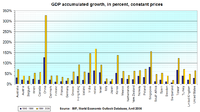
Photo from wikipedia
Land is an indispensable factor of production and the basic support for all social and economic activities. The COVID-19 epidemic has a great impact on China's macro-economy and land market.… Click to show full abstract
Land is an indispensable factor of production and the basic support for all social and economic activities. The COVID-19 epidemic has a great impact on China's macro-economy and land market. As a unit with a high concentration of economic entities, urban agglomeration is closely related to its land use economic efficiency. Under the impact of epidemic and the rigid constraints of the relative scarcity of land resources, improving the land use economic efficiency is crucial to the sustainable development of urban agglomerations. Taking the 10 major urban agglomerations in China as a case study, this paper constructs a theoretical and empirical analysis framework for the land use economic efficiency and its driving mechanism of urban agglomerations, and measures the land use economic efficiency of urban agglomerations from the aspects of single factor productivity and total factor productivity. The results show that the COVID-19 epidemic has a great impact on the land market of various cities in China's urban agglomerations. Whether single factor productivity or total factor productivity is used to measure land use economic efficiency of urban agglomerations, the driving effects of industrial agglomeration, industrial structure change, technological progress, and transportation infrastructure are all significant. It is necessary to take a series of measures to reform the market-oriented allocation of land elements, and improve a long-term mechanism for the smooth operation of the land market. It is necessary to improve the land use economic efficiency through a combination of industrial agglomeration, industrial structure adjustment, technological progress, and transportation infrastructure.
Journal Title: Frontiers in Public Health
Year Published: 2022
Link to full text (if available)
Share on Social Media: Sign Up to like & get
recommendations!